

Modelos de rúbricas para un blog de aula. Modelos de rúbricas para un blog de aula Posted in Experiencias educativas on Febrero 21, 2013SPACE BY Antonio Monje Fernández La brújula del tiempo es un blog creado en 2012 que pretende impulsar, desde la materia de Ciencias Sociales, la adquisición por parte del alumnado de competencias básicas a partir del diseño de proyectos de aprendizaje (AbP).
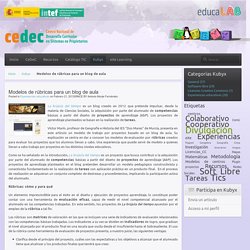
Los proyectos de aprendizaje planteados se basan en la realización de tareas. Víctor Marín, profesor de Geografía e Historia del IES "Dos Mares" de Murcia, presenta en este artículo un modelo de trabajo por proyectos basado en un blog de aula. Su explicación se centra en dar a conocer los modelos de evaluación por rúbricas creados para evaluar los proyectos que los alumnos llevan a cabo. Como se ha señalado en la introducción, La brújula del tiempo es un proyecto que busca contribuir a la adquisición por parte del alumnado de competencias básicas a partir del diseño de proyectos de aprendizaje (AbP). Rúbricas: cómo y para qué. Response: Ways To Include Students In The Formative Assessment Process - Classroom Q&A With Larry Ferlazzo.
RubiStar Home. SitComp. 135012677005. Bordón. Revista de pedagogía. 2011, Vol. 63, Nº 1. Grant Wiggins: Defining Assessment. Grant Wiggins is a nationally recognized assessment expert who has been working in assessment reform for more than twenty-five years.
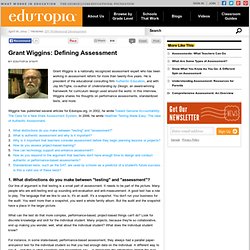
He is president of the educational consulting firm Authentic Education, and with Jay McTighe, co-author of Understanding by Design, an award-winning framework for curriculum design used around the world. In this interview, Wiggins shares his thoughts on performance assessments, standardized tests, and more. Wiggins has published several articles for Edutopia.org. In 2002, he wrote Toward Genuine Accountability: The Case for a New State Assessment System.
In 2006, he wrote Healthier Testing Made Easy: The Idea of Authentic Assessment. 1. Our line of argument is that testing is a small part of assessment. What can the test do that more complex, performance-based, project-based things can't do? Back to Top 2. Authentic assessment, to me, is not meant to be the charged phrase, or jargony phrase that it has come to be for a lot of people. How Should We Measure Student Learning? The Many Forms of Assessment. Linda: The United States is at a moment where it could really transform its assessment systems.
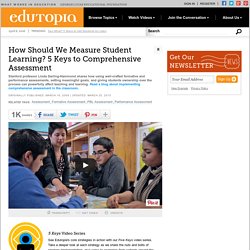
Most of our testing is multiple choice tests, pick one answer out of five, which is something you will never do in applying knowledge in the real world. Our assessments need to evolve to reflect the skills and knowledge that we actually value and that we need schools to teach and our children to learn. Human beings are naturally learners.
We are learning every moment of every day. In school, we have particular things to learn and we know that students learn more effectively when we're clear about what the goals are. Chinasa: I kind of like, I want like a goal in my head about what to do with information that I get. Erin: I look at the beginning of the year and I say, what are the big ideas that I want students to know in the whole year and what are the major skills I want them to be able to do? Linda: Assessment should occur early and often and throughout the process. Matriz de Valoración (Rúbricas - Rubrics en inglés) ¿QUÉ SON LAS RÚBRICAS?
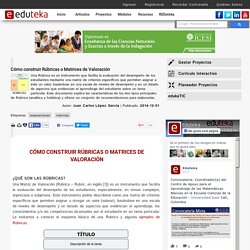
Una Matriz de Valoración (Rúbrica – Rubric, en inglés [1]) es un instrumento que facilita la evaluación del desempeño de los estudiantes, especialmente, en temas complejos, imprecisos o subjetivos. Este instrumento podría describirse como una matriz de criterios específicos que permiten asignar u otorgar un valor (valorar), basándose en una escala de niveles de desempeño y un listado de aspectos que evidencian el aprendizaje, los conocimientos y/o las competencias alcanzadas por el estudiante en un tema particular. Le invitamos a conocer el esquema básico de una Rubrica y algunos ejemplos de Rúbricas. Presentation Validity & Reliability. Rubrics for Assessment. Learn more about our Online Courses, Online Certificate Programs, and Graduate Degree.
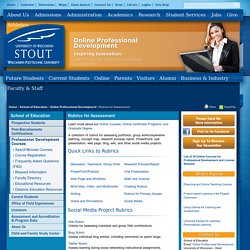
Reliability and Validity. Rubrics for Assessment. Classroom Assessment. The values for reliability coefficients range from 0 to 1.0.
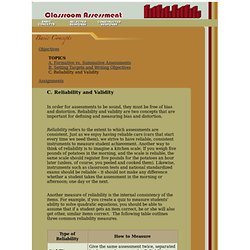
A coefficient of 0 means no reliability and 1.0 means perfect reliability. Since all tests have some error, reliability coefficients never reach 1.0. Generally, if the reliability of a standardized test is above .80, it is said to have very good reliability; if it is below .50, it would not be considered a very reliable test. Validity refers to the accuracy of an assessment -- whether or not it measures what it is supposed to measure. Even if a test is reliable, it may not provide a valid measure. There are three ways in which validity can be measured. So, does all this talk about validity and reliability mean you need to conduct statistical analyses on your classroom quizzes?